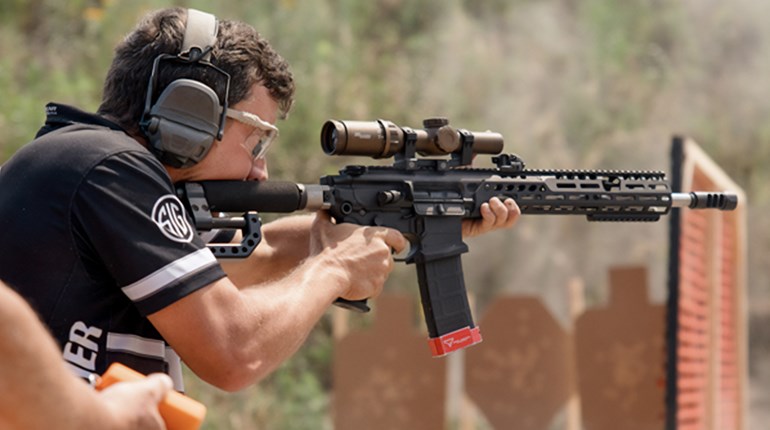
SIG P320 Update

We’ve spent a lot of ink—digital and otherwise—on the SIG P320. The rationale is uncomplicated: It’s a really fine pistol, and we don’t much mind who hears us say so. It’s also surprising in a minor respect: While we have always admired the quality, accuracy and durability of SIG arms, we struggled to run the pistols with the confidence we did many others. We had no illusions that the failings were other than our own. That happily came to an end with the P320. It’s still way better than we are, but the overt pointing and giggling has stopped. We think.
It’s making First Gear this week for a couple of reasons. For starters, we’ve now run a P320 for a solid first year, and believe those still considering might like an updated report. “Glorious,” should suffice.
With not quite 15,000 rounds through the “big dog” caliber (.45 ACP), we hauled it to a class not long ago. Students ranging in age from 15 to 40-something (both ladies and gents) shot it with gusto and precision, confirming many of the attributes which made us big fans in the first place: Particularly for a striker-fired pistol, the stock DAO trigger is easy to manage, and especially so if your mechanics are already sound. It’s also an especially “soft”-shooting .45 in terms of felt recoil, and should banish forever the notion that the slightly higher SIG bore line is adding to felt recoil. Shot side-by-side with competitors, it simply isn’t so for the vast majority.
As we’ve shot this pistol more and more, there’s another thing we’d like to see banished from the SIG “aura.” It’s subtle but pervasive, and we characterize it as the “pro” imprimatur. We’d absolutely support this in one sense—professionals of every stripe from law enforcement to special operations do indeed use SIG firearms in many roles.

But there’s another sense of this that needs to end forthwith, and that’s the apprehension that newer shooters—of which there are many these days—seem to have about choosing a SIG. Especially in the case of the P320, it isn’t a pistol you need to “step up to”; the famed quality, safety, accuracy and reliability may be the best place to start for new handgun shooters.
Then, of course, there’s the promised, down-the-road versatility of the P320 now delivered, and which gets us to the …
SIG P320 X-Change Kit
One of the coolest things about the P320 was a little hard to test, at least at the outset—the promised capacity for rapid, straightforward caliber conversion from 9 mm all the way up to .45 ACP. Such versatility is by no means new (even in shotguns and rifles), and has several advantages, but our favorite has always been the same: No need to accommodate to differences in trigger feel and function.
But what the SIG added to the equation was a true step forward: because every P320 is built around a serialized “core,” frame size could change too. The same guts that we shot all the way to USPSA L10 Nationals as a 29.4-ounce, 8x5.5x1.4” .45 could shrink to a 24.9-ounce 6.7x4.7x1.1” subcompact, carry-friendly 9 mm. A darn neat trick, especially when you consider that stops along the way in .40 S&W and .357 SIG were just as easy. If our math here was correct, there are some 6,900 possible combinations of caliber, slide/barrel length, grip length/diameter and magazine capacity.

Not long ago, we had the chance to test this for ourselves with the arrival of an X-Change Kit. The sad truth is, it does not make for very good—or at least very extended—reading: It would simply be a repeat of our previous P320 reports. Suffice it to say that the kit is exactly as promised: Straightforward, complete and utterly reliable. Swap time is about 75 seconds (and it can certainly be done faster, but why?), and this is for the whole mission: Extracting your “core,” and surrounding it with the new slide, guide rod/spring, frame module and magazine from your kit. Ours was a .40 S&W example, for which we were particularly grateful.
As tested in our first look, the 9 mm P320 was almost absurdly docile with all but the thumpiest ammunition; the .45 ACP, in its turn, seemed to transform the typical slow “wave” of recoil in the caliber into a mere swell. The .40 S&W splits the difference much as it does in other designs: Power is not deceptive. But what we also discovered is how unusually amenable the 320 in .40 S&W is to load “tuning.” The spring rate in the captured-type recoil assembly ran everything we chucked at it: 135-grain loads (at 1,308 ft./sec.) ran with the same facility as 200-grainers 600 ft./sec. slower. If the math is daunting, let us help: You can shoot a P320 in .40 over a range of energies that doubles, yet maintain accuracy, reliability and remarkable shooting comfort.
It’s cliché, we know, but: ’Nuff said?
Visit SIG Sauer at sigsauer.com.


































